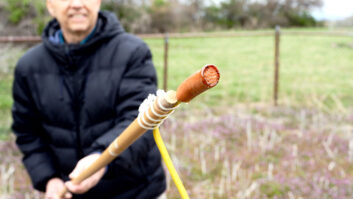If you use heaters on your satellite dishes, this is a good time to check them to make sure they work.
New Hampshire Public Radio’s Steven Donnell, a frequent Workbench contributor, has heaters on all of NHPR’s dishes. As a part of his fall maintenance program, he checks the AC current the heater draws when the heaters are on. This can be done easily at the heater controller or in the AC disconnect box at the base of the dish.
In addition, NHPR has installed toroidal transformers that sample the AC current draw in the mains feeding the heaters. This inexpensive technique allows staff to monitor heater operation through one of the meter channels on their Burk remote control equipment.
If the heater controller boxes are outside at the dish, Steven recommends a close internal inspection to make sure there are no unexpected residents living there.
In one instance, Steven had a heater fail because the controller box was infested with hundreds of tiny ants. Apparently, the exoskeletons of ants are fairly good insulators. After enough ants got squashed across the contacts of the main relay for the heater, it was enough to block the heaters from turning on.
Because National Public Radio still uses Galaxy 16, the NHPR dishes are at a fairly low “look angle.” Check your dish. If it is pointing up, think of it it as a snow scoop. Unless you add a dish cover and/or heaters, you’ll be slogging through the elements this winter keeping the dish clear of snow.
Steven also poses a question for readers: Do you have experience with the heaters used in Prodelin three meter dishes? Steven has a pair that are four years old, and he has experienced issues with the wiring that interconnects the heater pads. Any thoughts would be appreciated.
***
John Huntley is chief engineer for Townsquare Media Rockford in Illinois, as well as deacon for the Catholic Diocese of Rockford.
He reminds us of the concept “lockout-tagout.” This is a procedure established to prevent the operation of a transmitter or other dangerous equipment while work is being performed on it. Lockout-tagout can be as simple as throwing a circuit breaker off. But the “tagout” part is designed to let personnel know the breaker was supposed to be thrown off. The “local” button on your remote control system achieves the same — it prevents the “control” functions of the remote control from operating while you are working on the transmitter or other equipment.

Fig. 1: The orange lock in the lower foreground is a part of John Huntley’s lockout-tagout procedure.
Years ago while working on a transmitter, I kept hearing a click-click-click. Further investigation found the impatient jock hitting the “PLATE ON” button on the remote control. That “local” button saved my life!
In John Huntley’s case, Fig. 1 shows a lock hanging from the front of an old Collins antenna tuning unit. When work is being done, the jumper on the ATU input is removed and locked to the front of the ATU.
As there is now cellular on the tower fed by the ATU, this safety measure helps the cell crews relax a bit. For further safety, send the key to the lock up the tower with the climber.

Fig. 2: John’s AM site is seen at twilight, with the cellular cabinets and the isocoil from Kintronic Labs visible.
John heard a story about an engineer removing the circuit breaker feeding the FM transmitter, and sending it up the tower with the rigger. No way that transmitter will be switched on inadvertently! Sometimes “we do what we have to.”
John’s tower at this site is “hot” (series fed), so there is an isocoil on the RF power feed to the cellular radios. The isocoil cabinet was made by Kintronic Labs. The isocoil and cellular equipment are shown in Fig. 2. John’s consultant for the project was Stephen Lockwood of Hatfield & Dawson.
Adding a cell site to an AM tower is not an impossible task. It just requires educating the carrier’s design staff and using an outside consultant.
***
Greg Muir, principal with Wolfram Engineering, read our discussion in the Sept. 13 column about prepping parts before soldering. I mentioned the pencil-type erasers that many of us used for soldering prep. The “eraser” removes tarnish from component leads, making the soldering job easier.

Fig. 3: A pencil eraser from an artist supply store can be used to clean component leads prior to soldering.
Greg still remembers these eraser sticks, and buys and uses them. They are manufactured by Faber-Castell and are described as a 7058B ink eraser (UPC code: 400-5401 858003). The price ranges from $2 to $3 each, depending on where you buy it. Do an online search for the manufacturer and part number; you will find a bunch of art suppliers that handle this product.
Greg likes these pencil-type erasers, shown in Fig. 3, because you can sharpen them down to a very fine point for cleaning tiny contacts.
Contribute to Workbench. You’ll help fellow engineers and qualify for SBE recertification credit. Send Workbench tips to [email protected]. Fax to (603) 472-4944.
Author John Bisset has spent 48 years in the broadcasting industry and is still learning. He handles West Coast sales for the Telos Alliance. He is SBE certified and is a past recipient of the SBE’s Educator of the Year Award.












